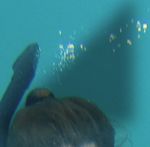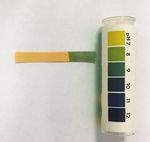How Carbon Dioxide Is Changing the Oceans
←
→
Page content transcription
If your browser does not render page correctly, please read the page content below
Scan the image of the
coral reef below with
the LinkReader
mobile app to
see more
about acidic
oceans.
This is concerning because although coral
reefs make up less than 1% of the Earth’s
surface, they play a crucial role in the ocean
ecosystem—corals provide shelter for perhaps
a quarter of the ocean’s species. This is why
researchers study changing ocean waters and
ask the important question: How will a warmer
and more acidic ocean affect corals and what
does that mean for the health of our oceans?
The greenhouse effect
How Carbon Dioxide Is
One of the lessons Ocean Camp instructors
gave earlier that week covered climate change
and how it affects the ocean. A culprit
Changing the Oceans
behind ocean warming and acidifica-
tion is an increase in carbon dioxide in
the atmosphere. Carbon dioxide and
other gases play a crucial role in the
By George Hale
A
Earth’s climate in what is called the
greenhouse effect: without them, the
EARTHWATCH.ORG; THINKSTOCK; LINKREADER VIDEO: https://youtu.be/6SMWGV-DBnk
LEXA ADJUSTS HER SNORKEL, MASK, AND FINS AS SHE PREPARES TO plunge planet would be cold and inhospitable.
into clear, blue water. She and four other U.S. high school students are two miles These atmospheric gases and a greenhouse
from Isla Ballena, an island off the Pacific coast of Costa Rica. The waters surround- work in quite different ways, but the resulting
ing the island—part of Costa Rica’s Marino Ballena National Park—contain coral effect, higher temperatures in both cases, has
reefs that attract visitors from around the world. The students are attending Ocean led to this description. Although this term is
Camp, a university-sponsored two-week research program that exposes students to misleading, it is commonly used.
oceanography and marine biology. Here, Alexa and her classmates will learn firsthand about A greenhouse is a building that is heated
marine life, as well as check the health of the reefs and 18 species of coral. with solar radiation so that it can stay warm
Along with their instructors and a snorkeling guide, the even in winter. Light from the sun passes
students swim past swaying tentacle-like coral polyps and through the glass roof to heat plants and the
colorful fish. All the while, they watch closely for corals that ground inside the greenhouse. These objects
have faded color or that seem to be weakened or crumbling. then emit infrared radiation, that is heat. Ther-
Alexa and her classmates have learned that these are signs mal energy is trapped in the greenhouse, keep-
of unhealthy corals, which are being threatened by warming
and increasingly acidic oceans due to rapid changes in the
Earth’s climate. Although corals typically thrive in warm water,
it places too much stress on them if the ocean gets too warm.
This causes them to lose their beautiful colors and turn white,
as if bleached. And a more acidic ocean can make it harder for
corals to get the materials they need to grow and that causes
them to weaken and crumble.
10 ChemMatters | FEBRUARY/MARCH 2018 www.acs.org/chemmattersing the building warm. The greenhouse effect 1. CO2(g) ⇌ CO2(aq)
is a natural process that warms the Earth’s Carbon dioxide gas dissolves in water.
surface. When the sun’s energy reaches the
Earth’s atmosphere, some of it is reflected
2. CO2(aq) + H2O ⇌ HCO3-(aq) + H+(aq)
Dissolved carbon dioxide reacts with water and dissociates into
back to space and the rest is absorbed by bicarbonate ion (HCO3-) and a hydrogen ion (H+). Because the ocean
the land and the oceans, heating the Earth. is basic (pH around 8.2), the H+ concentration is relatively low. As
The surface of the Earth loses energy back a result, this equilibrium is shifted almost completely to the right.
into space by emitting infrared radiation, but Only 0.5% of CO2 is found in seawater as dissolved CO2. Most
greenhouse gases absorb some of this infra- (89.5% is in the form of bicarbonate ion). Adding more CO2 from the
red light, retaining the energy on Earth and so atmosphere increases the amount of H+ present through this reac-
keeping it warm enough to sustain life. tion and contributes to lowering the pH of the ocean.
Human activities, such as burning fos-
sil fuels, agriculture and land clearing, are
3. HCO3–(aq) ⇌ CO32–(aq) + H+(aq)
It is more difficult for the second H+ to split off from the bicarbonate
increasing the amount of greenhouse gases, ion (it is not very acidic) and as a result only 10% of the dissolved
such as carbon dioxide, released into the CO2 is CO32– (aq).
atmosphere. This is trapping extra heat, and
causing the Earth’s temperature to rise. These 4. Ca2+(aq) + 2 HCO3–(aq) ⇌ CaCO3(s) + CO2(aq) + H2O
rising temperatures cause environmental Corals, plankton, and shellfish use calcium ions (Ca2+) and carbon-
changes, such as melting glaciers and ice ate ions (CO32-) to build their calcium carbonate skeletons and
sheets. shells, a process known as calcification. Equation 4 shows the pre-
cipitation reaction of calcium ions and hydrogen carbonate, which
Excess heat is not limited to the air. Ocean
react in the ocean to form calcium carbonate. As the acidity of the
temperatures have also increased,
ocean increases, the H+ concentration increases, there is less HCO3-
which affects coral reefs around the and more CO2 (aq) available (see equation 2), and this equilibrium
world. When water becomes too warm, shifts to the left. The minor carbonate species (in equation 3) can
corals can become stressed, and they also react with calcium ion to form calcium carbonate, but there is
expel the symbiotic algae living in also relatively less of it too with increasing H+. This makes it more
their tissues. Without the algae, the coral difficult for calcium carbonate to form, which means shells can’t
loses its major source of food, turns white or form as readily.
very pale, and is more susceptible to disease.
Oceanographer
Kathryn Shamberger
says ocean pH has
dropped from Not
8.2 to 8.1 acidic?
Bleaching in Kaneohe Bay in Hawaii
Oceans are still in
the basic pH range,
Carbon dioxide’s effects on the ocean go
beyond warming, though. The ocean has dis-
Shifting ocean pH but they are becoming
more acidic (or less
THE OCEAN AGENCY/XL CATLIN SEAVIEW SURVEY; NOAA; SHUTTERSTOCK
solved a lot of carbon dioxide, which keeps As a result of shifting the carbonate-bicar- basic).
it out of the atmosphere. But as the concen- bonate equilibrium, the pH of the ocean is also
tration of carbon dioxide in the atmosphere changing. Texas A&M University oceanogra-
increases, even more is added to the ocean, pher Kathryn Shamberger says ocean pH has reefs block and deflect some of the energy of
and it changes the water’s chemistry. As dropped from 8.2 to 8.1. Continuing to release ocean waves, meaning that water between the
shown in the first equation above, carbon dioxide at the current rate will mean shore and reef is calmer than it would be oth-
gaseous carbon dioxide dissolves in the oceans will continue to increase in acidity. erwise. If coral structures weaken, they could
ocean surface water to produce aque- The loss of reef habitats and damage to be damaged by storms, severely reducing this
ous carbon dioxide. Carbon dioxide reacts species either directly or through disruptions calming effect. In addition, habitat loss for
with the water molecules and releases hydro- to the food web could also affect human the 25% of ocean species that call coral reefs
gen ions, increasing the pH. populations. In many areas of the world, coral home could have far-reaching effects.
ChemMatters | FEBRUARY/MARCH 2018 11Coral in American Samoa before, during, and after a coral-bleaching event.
Ocean acidification also presents economic SELECTED REFERENCES
risks. An acidifying ocean could harm fish and Barkley, H. et al. Changes in Coral Reef
Communities across a Natural Gradient in
shellfish that humans eat, either directly or Seawater pH. Science Advances, Science, June
by eliminating food sources for commercially 2015, 1 (5): http://advances.sciencemag.org/
valuable species of fish. content/1/5/e1500328.
Also, about 12% of the world’s population Coral Reefs in Palau Surprisingly Resistant
to Naturally Acidified Waters. Woods Hole
earns a living through fishing, accounting for Oceanographic Institution, Jan 16, 2014:
nearly $150 billion worldwide in 2014. Thus, https://www.whoi.edu/news-release/palau-corals.
TOP IMAGE © THE OCEAN AGENCY / XL CATLIN SEAVIEW SURVEY / RICHARD VEVERS; MIKE MAO, EARTHWATCH.ORG; SHUTTERSTOCKK; ROBERTS@USGS.GOV
ocean acidification is another factor fisheries Wisshak, M. et al. Ocean Acidification Accelerates
Reef Bioerosion. PLOS One.org, Sept 18,
will have to consider when planning for the
2012: http://journals.plos.org/plosone/
future. Students researching and documenting article?id=10.1371/journal.pone.0045124.
coral reefs. What Is Ocean Acidification? Woods Hole
Bringing it all home and ocean pH are changing faster now than
Oceanographic Institution: http://www.whoi.edu/
ocean-acidification/.
These students have a lot to think about in the past. Alexa and her classmates found Kolbert, E. Unnatural Selection. The New Yorker,
April 18, 2016: https://www.newyorker.com/
when they return from Costa Rica. Over the out how increasing carbon dioxide in the air magazine/2016/04/18/a-radical-attempt-to-save-
course of two weeks they have learned about affects the ocean through changes in carbon- the-reefs-and-forests.
how the oceans interact with the overall ate and bicarbonate ion concentrations and Costa Rica: Snorkeling Tour at Marino Ballena
National Park. Anywhere.com: http://www.any-
climate and how human activities can affect pH, how those changes might affect coral
wherecostarica.com/destinations/uvita/tours/
ocean life. Future scientists will reefs, and what that could mean for the rest snorkeling-at-the-marino-ballena-national-park.
need to understand how pollu- of the ocean, as well as for marine life and the The Oceans Today. Marine Stewardship Council:
tion, warming, and ocean acidi- human population. https://www.msc.org/healthy-oceans/the-oceans-
today/the-oceans-today.
fication affect marine life and The lessons these students
come up with ways to reduce learned and activities they par-
atmospheric carbon dioxide and ticipated in, particularly their George Hale is a science writer who lives in Pearland,
its impact on the oceans. snorkeling tour of a coral reef, Texas. This is his first article in ChemMatters.
The students see that although harmful, will give new perspectives on
ocean acidification affects coral reefs differ- oceans and oceanography. What
ently around the world, possibly because of they learned will serve as a guide for their
variations in pH or ocean chemistry. They course of study after high school, because
learned how ocean water, sea-floor sediments, even though we know quite a bit about cli-
and even Arctic and Antarctic ice are showing mate change and the oceans, there is still a
scientists that atmospheric carbon dioxide great deal to figure out.
12 ChemMatters | FEBRUARY/MARCH 2018 www.acs.org/chemmattersYou can also read



























































